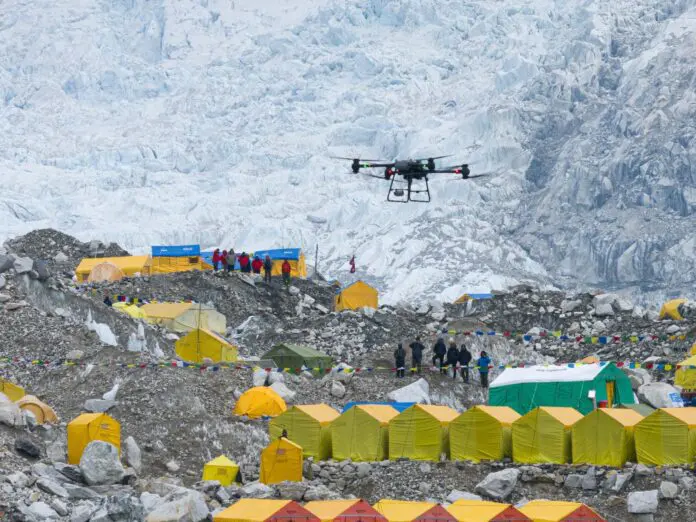
By Kelly Hill June 7, 2024
Collected at : https://www.rcrwireless.com/20240607/test-and-measurement/test-and-measurement-dji-tests-drone-delivery-on-mount-everest
Drone company DJI says that for the first time, drones have been used to safely deliver equipment to climbers on Mount Everest and remove trash from the mountain.
DJI completed test flights in April on Everest with its FlyCart 30, which carried three oxygen bottles plus 1.5 kilograms of other supplies from Everest Base Camp at about 5,300 meters above sea level, over the treacherous Khumbu Icefall to Camp 1 at approximately 6,000 meters ASL. At such altitudes, the air is very thin and aircraft struggle to stay aloft. DJI said that its FlyCart 30 is designed to carry 15 kilograms (about 33 pounds) in extreme altitude and environmental conditions. Prior to the delivery flights, the company said, the drone underwent “rigorous” tests for wind resistance, tolerance of low temperatures, and weight capacity tests with successively heavier payloads. The FlyCart 30 is a new model, just introduced in January of this year.
Pictures provided by DJI show the oxygen canisters suspended on a long line, being carried by the drone. The bottles and other supplies were carried up the mountain by the drone, and it carried trash down on the return trip.


Hauling equipment including supplies and bottled oxygen up the mountain is usually the task of Sherpa guides. “We need to spend 6-8 hours each day walking through this icefall,” said Mingma Gyalje Sherpa, a mountain guide for Imagine Nepal, in a press statement. “Last year I lost three Sherpas. If we’re not lucky, if our time is not right, we lose our life there.”
Comparatively, DJI said that an unmodified drone carrying 15 kg can make a round trip in 12 minutes. Drones also offer a faster and less risky way to remove trash from Everest, which has been a problem on the peak for decades.
“From the end of April, our team embarked on a groundbreaking endeavor to help make cleanup efforts on Everest safer and more efficient,” said Christina Zhang, senior corporate strategy director at DJI. “We are thrilled to share that our DJI FlyCart 30 was up to the task. The ability to safely transport equipment, supplies, and waste by drone has the potential to revolutionize Everest mountaineering logistics, facilitate trash cleanup efforts, and improve safety for all involved.”
DJI noted that climbing on Everest is restricted to April and May, which are the most favorable weather months; so more drone testing for the rest of the year is also restricted. “However, because of recent successful trials, the Nepalese government contracted a local drone service company to establish drone delivery operations on the southern slope of Everest starting on May 22,” the company said.
In other test news:
-ICYMI: EchoStar, Mavenir and Qualcomm worked together to test 5G Reduced Capability (RedCap) on the Boost Mobile Network, in a demonstration that the partners said was the first validation of 5G RedCap capabilities in an Open virtualized Radio Access Network (Open vRAN). More details in this piece.
–Keysight Technologies is prepping for upcoming conferences this summer, and plans to highlight a variety of spectrum-related test and characterization solutions at the IMS 2024 show later this month, as well as a pre-6G proof-of-concept demonstration with Ericsson at the IEEE International Conference on Communications event.
–Opensignal put out new analysis this week of the market impact and network impact of 5G Fixed Wireless Access. While there have been concerns about the impact that FWA will ultimately have on network capacity and performance, the company found that high-penetration FWA areas actually have better performance than low-penetration FWA areas. Read all about it here.
–Viavi Solutions and Rohde & Schwarz continue to tout their recently expanded joint, integrated test solutions for Open RAN testing, including open Radio Unit (O-RU) conformance testing, energy savings and test scalability.
Viavi also said this week that it has released O-RU conformance, performance, security and subsystem interoperability tests based on O-RAN Alliance specifications, through its Viavi Automated Lab-as-a-Service for Open RAN, or VALOR. VALOR was made possible by a $21.7 million federal grant and is part of a major U.S. federal project focused on Open RAN interoperability, network performance and security and new testing methods.

Leave a Reply